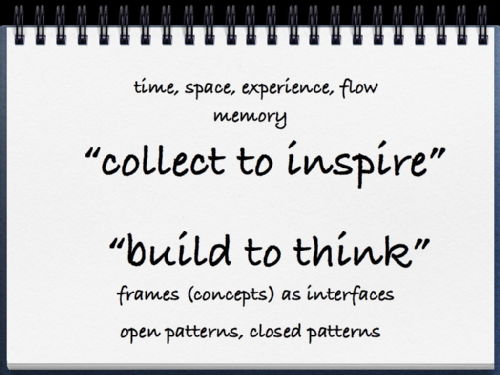All 3 entries tagged Osl
View all 4 entries tagged Osl on Warwick Blogs | View entries tagged Osl at Technorati | There are no images tagged Osl on this blog
June 25, 2010
OSL Design Concept: A Geography of Shared Concerns
The second part of the Handbook of Open-space Learning Technology will consist of a series of "design concepts" - experiments in OSL design using new technologies. The OSL design challenge is outline in Part One of the handbook. I am basing the design concepts on sessions that I have observed at Warwick, and other activities used by members of the project team. We can implement some of the designs with the available technology. Others are rather more "blue sky". I hope that people will be able to suggest products that make them feasible!
Here's one that tends more towards the experimental end of the scale...
A Geography of Shared Concerns (adapted from an original OSL activity designed by Professor Jonothan Neelands)
The room, about 20 metres by 10 metres, well lit but sparsely equipped, contains only five significant elements:
1. At one end, a long series of tables, upon which are placed an eclectic collection of handleable objects;
2. At the other end, the participants, in this case 12 third-year undergraduate students who are starting to identify topics for their dissertation projects;
3. With the students, the workshop facilitator;
4. Along one side, a large interactive digital display;
5. In the middle, a large white rectangular surface placed flat onto the ground.
The lights are dimmed, except for spotlights illuminating the table of objects. A vertically mounted overhead projector throws an image down onto the white screen in the middle of the floor. The projected image, spread across the floor, is of a map, representing a coastline. There is land, with some features. An ocean, complete with gently moving waves. And between land and sea, a large golden beach.
The participants immediately get the connection between the table of objects and the projected map. The objects are each in some way representative of one of the three geographical zones: transport (of various kinds including a submersible), buildings, personal effects (including a wellington boot), animals etc.
The workshop facilitator walks over to the table. She explains the task:
“Think about all of the different topics that you have studied in the first two years of your degree. All of the issues, techniques, problems, people, concepts that have concerned or inspired you. Pick just one of those topics. Choose the one that you care most about, the one that has been of most interest to you.”
“Next, examine the objects on the table. Pick them up, handle them. Think about their characteristics and what they suggest to you: (speed, safety, excitement etc). Choose an object that somehow represents your chosen topic. Attach your personal RFID tag to the object.”
Each participant has their own personal Radio Frequency Identification (RFID) tag. When placed on an object, it identifies it as “belonging” to that person. An RFID reader is then able to specify the physical location of the tag.
The facilitator picks an object from the table.
“Your task then is to think about where that object should go on the map. Perhaps you are happily sailing far out to sea? Or perhaps you are out of your depth? Place the
She places the object onto the map. She then activates the interactive screen at the side of the room. The landscape is now also shown on the screen, but with the addition of an image of the facilitator next to a blank digital post-it note. It is placed in the same location as the real object on the floor map.
“And finally, find your post-it note on the screen, and write down a brief description of your chosen object and the topic that it represents.”
She picks up a digital pen and demonstrates writing onto her post-it.
“Don’t worry if you change your mind, you can move your object, change objects, delete your notes. After 15 minutes we will save the map with your notes posted to it. I’ll upload it to our class blog.”
The students understand. There’s even a bit of a rush as they get over to the table to choose. After much playing around with topics and objects, placing them at various locations and considering the implications, the 15 minutes are over. It’s all been quite a bit of fun. Playful. But also serious. A chance to reflect upon their own learning and upon their subject discipline. An opportunity to find others with similar interests and concerns (talking to their immediate neighbours on the map), but also a prompt to look at and investigate choices that are very different to their own – to consider new possibilities and alternative connections. Perhaps even providing them with the inspirations that they will need to successfully choose and complete a dissertation project.
To respond to this design, please go to the OSL blog.
July 10, 2009
Open Space Learning – initial tasks
Some initial tasks for the Open Space Learning project:
- Design a framework for case studies
- Pre and post event interviews
- Key questions, parameters
- Filming of events
- Gathering of online materials
- Learning design patterns
- Getting students involved and contributing, capturing feedback fast and immediately
- Survey people who support OSL activities, consider how they can be supported and practice developed and communicated
- Set up some activities to demonstrate technology and techniques or away day
 Robert O'Toole
Robert O'Toole

 Please wait - comments are loading
Please wait - comments are loading






